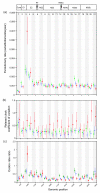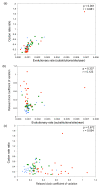The mode and tempo of hepatitis C virus evolution within and among hosts
- PMID: 21595904
- PMCID: PMC3112090
- DOI: 10.1186/1471-2148-11-131
The mode and tempo of hepatitis C virus evolution within and among hosts
Abstract
Background: Hepatitis C virus (HCV) is a rapidly-evolving RNA virus that establishes chronic infections in humans. Despite the virus' public health importance and a wealth of sequence data, basic aspects of HCV molecular evolution remain poorly understood. Here we investigate three sets of whole HCV genomes in order to directly compare the evolution of whole HCV genomes at different biological levels: within- and among-hosts. We use a powerful Bayesian inference framework that incorporates both among-lineage rate heterogeneity and phylogenetic uncertainty into estimates of evolutionary parameters.
Results: Most of the HCV genome evolves at ~0.001 substitutions/site/year, a rate typical of RNA viruses. The antigenically-important E1/E2 genome region evolves particularly quickly, with correspondingly high rates of positive selection, as inferred using two related measures. Crucially, in this region an exceptionally higher rate was observed for within-host evolution compared to among-host evolution. Conversely, higher rates of evolution were seen among-hosts for functionally relevant parts of the NS5A gene. There was also evidence for slightly higher evolutionary rate for HCV subtype 1a compared to subtype 1b.
Conclusions: Using new statistical methods and comparable whole genome datasets we have quantified, for the first time, the variation in HCV evolutionary dynamics at different scales of organisation. This confirms that differences in molecular evolution between biological scales are not restricted to HIV and may represent a common feature of chronic RNA viral infection. We conclude that the elevated rate observed in the E1/E2 region during within-host evolution more likely results from the reversion of host-specific adaptations (resulting in slower long-term among-host evolution) than from the preferential transmission of slowly-evolving lineages.
Figures



References
-
- Hepatitis-C FAQs for the Public. http://www.cdc.gov/hepatitis/C/cFAQ.htm#statistics
Publication types
MeSH terms
LinkOut - more resources
Full Text Sources
Medical
Molecular Biology Databases

